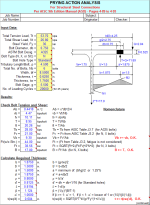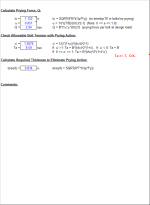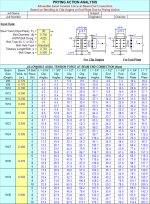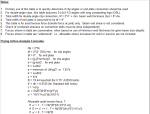PRYING9.xls

Description
"PRYING9" is a spreadsheet program written in MS-Excel for the purpose of analysis for prying action in structural steel connections per the AISC 9th Edition (ASD) Code, pages 4-89 to 4-95. Specifically, bolt tension and bolt shear are checked, and the prying force and required thickness are determined.
This program is a workbook consisting of three (3) worksheets, described as follows:
- Doc - Documentation sheet
- Prying Action - Prying action analysis for connections per AISC 9th Edition (ASD) Manual
- Allowable Tension Force - Allowable axial tension force at beam connection from bending due to prying
Program Assumptions and Limitations:
1. The Prying Action worksheet is valid for connections subjected to tension only, or to a combination of tension and shear.
2. The Prying Action worksheet is only applicable for connection bolt diameters from 1/2” to 1-1/2 “
3. The Prying Action worksheet is only applicable for ASTM A325 or A490 high-strength connection bolts.
4. The Prying Action worksheet is applicable to connection bolts in bearing with threads included in shear plane(N) or threads excluded from shear plane (X), as well as bolts in a slip critical connection (SC).
5. The Prying Action worksheet is applicable to connections with either standard or oversized bolt holes.
6. The Prying Action worksheet also takes fatigue effects into account when required to reduce the allowable bolt tension stress.
7. The Allowable Tension Force worksheet has any applicable assumptions and limitations listed directly below the tables of values.
8. This program contains numerous “comment boxes” which contain a wide variety of information including explanations of input or output items, equations used, data tables, etc. (Note: presence of a “comment box” is denoted by a “red triangle” in the upper right-hand corner of a cell. Merely move the mouse pointer to the desired cell to view the contents of that particular "comment box".)
Calculation Reference
AISC
Calculation Preview
Full download access to any calculation is available to users with a paid or awarded subscription (XLC Pro).
Subscriptions are free to contributors to the site, alternatively they can be purchased.
Click here for information on subscriptions.
Comments: 6
×
hades3
12 years ago
Thanks!
16 years ago
In the stored example that I have, maybe you first tried changing the bolt size to 1/2" without paying any attention to the loads?
For bolts, you will get #NUM errors first originating in the calculation of the allowable bolt tension stress, Ft, for interaction with shear. Since you are taking the square root of a quantity, if that quantity becomes less than 1, then you are trying to take the square root of a negative number....and you know what happens from there, and so on. If your shear load is too great, then there will be no calculated capacity for tension.
Alex
For bolts, you will get #NUM errors first originating in the calculation of the allowable bolt tension stress, Ft, for interaction with shear. Since you are taking the square root of a quantity, if that quantity becomes less than 1, then you are trying to take the square root of a negative number....and you know what happens from there, and so on. If your shear load is too great, then there will be no calculated capacity for tension.
Alex
16 years ago
Most likely, you've got too much shear to calculate any allowable bolt tension stress for the 1/2" bolts. It tries to take the square root of a negative number.
16 years ago
Most likely, you've got too much shear to calculate any allowable bolt tension stress for the 1/2
17 years ago
This morning while using the "Prying Action" worksheet of the "PRYING9.xls" workbook, a problem was discovered. For situations where fatigue needs to be considered ( > 20,000 cycles), the allowable bolt tension stress is be reduced. The program did in fact do that for "N" and "X" type bearing bolts. However, it was not reducing the allowable bolt tension stress for fatigue when using slip critical (SC) bolts.
This has been corrected and the workbook is now version 2.0. I will continue to provide updates for any of the AISC 9th Edition spreadsheet workbooks as long as people appear to still be using them.
This has been corrected and the workbook is now version 2.0. I will continue to provide updates for any of the AISC 9th Edition spreadsheet workbooks as long as people appear to still be using them.




